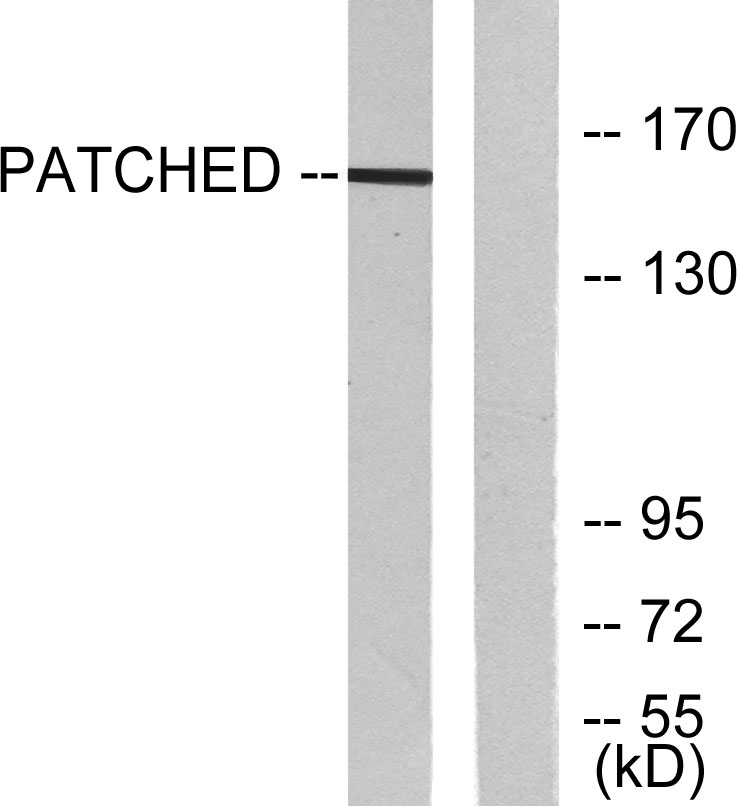Patched Polyclonal Antibody
- Catalog No.:YT3598
- Applications:WB;IHC;IF;ELISA
- Reactivity:Human;Mouse
- Target:
- Patched
- Fields:
- >>cAMP signaling pathway;>>Hedgehog signaling pathway;>>Axon guidance;>>Pathways in cancer;>>Proteoglycans in cancer;>>Basal cell carcinoma
- Gene Name:
- PTCH1
- Protein Name:
- Protein patched homolog 1
- Human Gene Id:
- 5727
- Human Swiss Prot No:
- Q13635
- Mouse Gene Id:
- 19206
- Mouse Swiss Prot No:
- Q61115
- Immunogen:
- The antiserum was produced against synthesized peptide derived from human Patched. AA range:1-50
- Specificity:
- Patched Polyclonal Antibody detects endogenous levels of Patched protein.
- Formulation:
- Liquid in PBS containing 50% glycerol, 0.5% BSA and 0.02% sodium azide.
- Source:
- Polyclonal, Rabbit,IgG
- Dilution:
- WB 1:500 - 1:2000. IHC 1:100 - 1:300. ELISA: 1:10000.. IF 1:50-200
- Purification:
- The antibody was affinity-purified from rabbit antiserum by affinity-chromatography using epitope-specific immunogen.
- Concentration:
- 1 mg/ml
- Storage Stability:
- -15°C to -25°C/1 year(Do not lower than -25°C)
- Other Name:
- PTCH1;PTCH;Protein patched homolog 1;PTC;PTC1
- Observed Band(KD):
- 160kD
- Background:
- This gene encodes a member of the patched gene family. The encoded protein is the receptor for sonic hedgehog, a secreted molecule implicated in the formation of embryonic structures and in tumorigenesis, as well as the desert hedgehog and indian hedgehog proteins. This gene functions as a tumor suppressor. Mutations of this gene have been associated with basal cell nevus syndrome, esophageal squamous cell carcinoma, trichoepitheliomas, transitional cell carcinomas of the bladder, as well as holoprosencephaly. Alternative splicing results in multiple transcript variants encoding different isoforms. Additional splice variants have been described, but their full length sequences and biological validity cannot be determined currently. [provided by RefSeq, Jul 2008],
- Function:
- developmental stage:In the embryo, found in all major target tissues of sonic hedgehog, such as the ventral neural tube, somites, and tissues surrounding the zone of polarizing activity of the limb bud.,disease:Defects in PTCH1 are a cause of sporadic basal cell carcinoma (BCC) [MIM:605462].,disease:Defects in PTCH1 are probably the cause of basal cell nevus syndrome (BCNS) [MIM:109400]; also known as Gorlin syndrome or Gorlin-Goltz syndrome. BCNS is an autosomal dominant disease characterized by nevoid basal cell carcinomas (NBCCS) and developmental abnormalities such as rib and craniofacial alterations, polydactyly, syndactyly, and spina bifida. In addition, the patients suffer from a multitude of tumors like basal cell carcinomas (BCC), fibromas of the ovaries and heart, cysts of the skin, jaws and mesentery, as well as medulloblastomas and meningiomas. PTCH1 is also mutated in squamo
- Subcellular Location:
- Cell membrane ; Multi-pass membrane protein .
- Expression:
- In the adult, expressed in brain, lung, liver, heart, placenta, skeletal muscle, pancreas and kidney. Expressed in tumor cells but not in normal skin.
Inhibitory Effect of Ursolic Acid on Proliferation and Migration of Renal Carcinoma Cells and Its Mechanism WB Human /786-O cell
Targeting Hedgehog signalling in CD133-positive hepatocellular carcinoma: improving Lenvatinib therapeutic efficiency. MEDICAL ONCOLOGY Med Oncol. 2021 Apr;38(4):1-11 WB Human SK-Hep-1 cell,MHCC97H cell
Sun, Mingjuan, et al. "Hedgehog pathway is involved in nitidine chloride induced inhibition of epithelial-mesenchymal transition and cancer stem cells-like properties in breast cancer cells." Cell & bioscience 6.1 (2016): 44.
- June 19-2018
- WESTERN IMMUNOBLOTTING PROTOCOL
- June 19-2018
- IMMUNOHISTOCHEMISTRY-PARAFFIN PROTOCOL
- June 19-2018
- IMMUNOFLUORESCENCE PROTOCOL
- September 08-2020
- FLOW-CYTOMEYRT-PROTOCOL
- May 20-2022
- Cell-Based ELISA│解您多样本WB检测之困扰
- July 13-2018
- CELL-BASED-ELISA-PROTOCOL-FOR-ACETYL-PROTEIN
- July 13-2018
- CELL-BASED-ELISA-PROTOCOL-FOR-PHOSPHO-PROTEIN
- July 13-2018
- Antibody-FAQs
- Products Images

- Sun, Mingjuan, et al. "Hedgehog pathway is involved in nitidine chloride induced inhibition of epithelial-mesenchymal transition and cancer stem cells-like properties in breast cancer cells." Cell & bioscience 6.1 (2016): 44.

- Immunohistochemical analysis of paraffin-embedded Human Right kidney. 1, Antibody was diluted at 1:100(4° overnight). 2, High-pressure and temperature EDTA, pH8.0 was used for antigen retrieval. 3,Secondary antibody was diluted at 1:200(room temperature, 30min).

- Western blot analysis of lysates from mouse muscle cells, using Patched Antibody. The lane on the right is blocked with the synthesized peptide.



